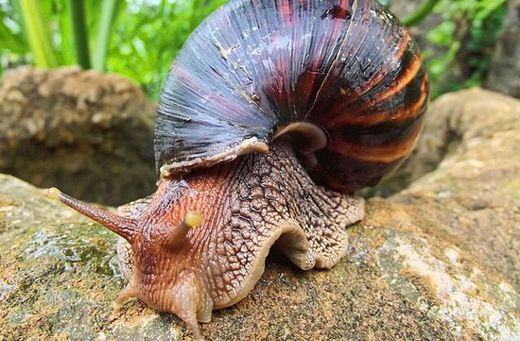
© Wikimedia Commons/Sonel.SAThe giant African land snail is causing problems for Floridians.
Florida plant detectives are on the trail of a slippery foe, an invasive African land snail that is wily, potentially infectious, and can grow as big as a tennis shoe.
In the four years since Giant African Snails were discovered in Miami, they have slowly but surely spread to new territory, alarming residents in the southern suburbs and the neighboring county of Broward.
Their slimy tracks have led agricultural experts on an odyssey of discovery about animal behavior, folk religion and the precise amount of chemicals and cash it takes to kill the world's biggest gastropods.
Since 2011, Florida has spent $10.8 million on the Giant African Snail eradication program, according to state agriculture department spokesman Mark Fagan.
That is 10 times more than officials spent to wipe out the snails' last invasion of Florida in the 1960s, an effort that lasted an entire decade.
And there is still no end in sight.
"The fact is they're
a human and animal health threat and they're a threat to Florida's agriculture," said Fagan.
"We can't let the population continue."
The snails are
voracious consumers of as many as 500 different plants, and are also known to eat the stucco off houses.If they consume infected rat feces, the snails can carry a parasitic worm that is dangerous to humans and can cause a rare form of meningitis.They are also huge. The biggest one found in Florida was nearly seven inches (18 centimeters) long.
At first, officials tried to kill the giant snails with organic pesticides, to no avail. Then they switched to a molluscicide containing metaldehyde, which kills them 95 to 100 percent of the time.
But the
snails sometimes climb trees to avoid the chemical pellets on the ground, said Florida Department of Agriculture scientist Mary Yong Cong, who keeps a few in her Miami office to observe their behavior.
"They are very curious," she said, holding one in her hand as it extended its tentacle-eyes toward a visiting reporter.
Adding to their reproductive success, the snails are hermaphrodites, and they can lay up to 1,200 eggs per year. Their eggs look like miniature chicken eggs, each about the size of a Tic Tac.
The snails can disappear for months, hibernating below ground, only to resurface in hurricane season when it is warm and wet.Officials have set up a snail-sighting hotline, and regularly dispatch workers armed with gloves and rakes to help clear them away.
Authorities thought they had a good handle on them last year.
But then nearly 5,000 live snails were discovered in September 2014, in and around a single house in the wealthy Miami suburb of Pinecrest.
Never before had officials seen one home so overwhelmed with giant snails. The owners lived in the house, regularly landscaped their yard and ran the sprinklers outside to keep the grass green.
"It was a paradise for snails," said Yong Cong.
No one is really sure how the snails got to Florida, but some believe they were smuggled in by people who practice Afro-Caribbean folk religions which use the snails in their rituals.
When the snails were first discovered in south Florida, Santeria was blamed.
"As always takes place, everything that is strange gets labeled under my religion, Santeria," said Ernesto Pichardo, a leading expert and practitioner.
"And we were all like, 'Excuse me, no! This is the first time I have ever seen this beast,'" he recalled.
"It does what? It eats stucco?"
Rather, Santeria uses the small, native Florida snails occasionally in ritual offerings to honor creation, but they are never eaten, he said. Either they are killed or let go after the ritual is over.
Pichardo said Giant African Snails are instead used by traditionalists of the Yoruba people, native to Nigeria and some neighbouring parts of West Africa, who believe drinking the snail's mucus can cure certain ailments.
Since it is illegal to possess Giant African Snails in Florida, the practice remains cloaked in secrecy.
Officials are not aware of any cases of illness due to giant snail ingestion in Miami, but they say the risk is real.
The latest phase in the response has been to unleash sniffer dogs on the snails' trail.
Two labradors, specifically trained to sit if they get a whiff, are employed by the Department of Agriculture.
Omar Garcia, one of the dog handlers, said their primary job is to provide an extra layer of confirmation that all the snails are gone following a chemical treatment.
"Sometimes we receive tips from the general public and we'll go out and search," he added.
Experts have removed 158,000 of the giant snails in the past four years.
The latest discovery of live giant snails was in a new neighborhood south of Miami in April.
Snails were found outside four houses, and were quickly killed off.
"They were all underneath this tree, and they've gotten rid of everything," homeowner Meredith Parker told AFP in July.
But officials won't be able to say the snails are gone for good until two years has passed since the last giant snail is found alive in the wild.
Source: Agence France-Presse
Wonder if they're edible.